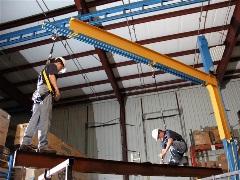When it comes to engineered fall protection, there is mass confusion out there. Decision-makers are confused about the various requirements; they are confused about the roles and responsibilities involved in making the final decision on equipment purchases; and certainly are confused about how to choose the right fall protection solution for specific applications.
Gorbel, a leading manufacturer of engineered fall protection solutions, turned to several industry experts to help clarify some of these issues. The complete findings, and potential solutions, are found in the ebook, “Fall Arrest: Insights and Ideas for Workplace Compliance,” which is available for download at www.gorbel.com/righttrack. This article provides a summary of common issues, as well as solutions.

Problem: Installing incomplete or inadequate fall protection.
Due to lack of clarity regarding fall protection requirements, many businesses select a fall protection product that isn’t alwaysthe best solution for their individual application. While any fall protection is probably better than no fall protection, inadequate or incomplete fall protection could potentially still expose them to risk. What Gorbel heard often from the experts was, “work doesn’t stop if you don’t have a fall protection system.” Translation: it’s not a top priority. The problem with that mindset is the increased potential for catastrophic risk to your workers and your business.
Solution: Choose a system designed specifically for your application.
The experts all advise going with a fall arrest anchorage system that is engineered specifically for your application. Whether your application is maintenance, production, unloading or reloading, engineered solutions can offer the safest and most productive option for fall arrest.
Gorbel offers an Anchorage Assessment tool, also available for download at www.gorbel.com/righttrack, that will help you determine whether an engineered fall arrest system is right for you.
Problem: Fall protection is considered a discretionary spend.
Despite a clear mandate that fall protection be implemented for workers at elevations above four feet, often businesses still consider it “optional,” which exposes them to considerable risks like hefty fines, workplace shutdowns, legal fees, and medical bills related to a fall.
For general industry, OSHA requires that workers be protected at heights greater than four feet. OSHA regulations are legislation and must be followed under penalty of law.
In addition to federal regulations, there are “voluntary” consensus standards regarding fall protection set forth by the American National Standards Institute (ANSI) and Canadian Standards Institute (CSA). While not enforceable by law, these standards are typically adopted by OSHA or other regulatory agencies and should be adhered to.
Solution: Elevate your fall protection planning.
If you’re responsible for an elevated workforce, it pays to plan ahead. Doing so can save lives and help reduce risk for the company you work for.
To assist you in the planning process, Gorbel offers tools that provide more information on fall arrest and how to determine what type of system might be right for you. The Fall Protection Planning Resource and Fall Protection Toolkit are both available for download at www.gorbel.com/righttrack.
Problem: Decision by committee – without the right information.
The experts agree: many businesses simply don’t know how to go about making the right fall protection choice. Because a fall protection decision is often made in the wake of an accident, decisions are sometimes made hastily based on financial considerations and not what is safest or best for the workers.
Solution: Assemble the right fall protection team.
Assembling the appropriate team to choose, implement and manage the best solution is key to the process. It’s imperative to include the right mix of decision makers and influencers, and designate clear roles and responsibilities.
Recommendations on who should be involved in the fall protection committee, as well as their roles and responsibilities, is available in the full ebook at www.gorbel.com/righttrack.
The final step: Engineering the right solution
With all of these insights, solutions, and tools in hand, you will be well prepared to make an informed decision on a fall protection solution. Your final step is to select a system that is designed to protect you from occupational fines, reduce your liability and raise worker productivity and morale.